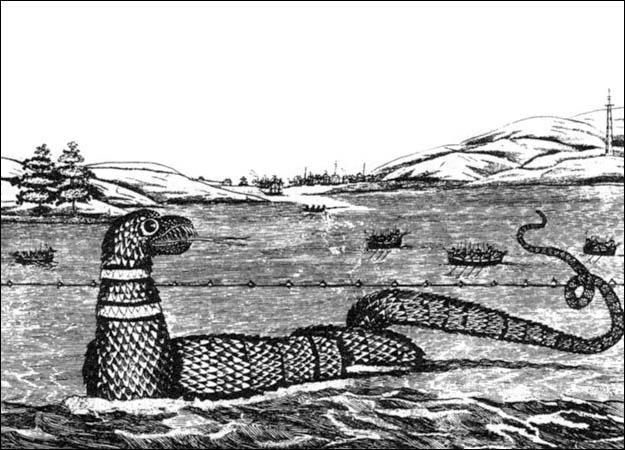Reviving Gloucester’s Sea Serpent
Posted by: Craig Woolheater on May 28th, 2011

The legend of either Gloucester’s biggest fish tale or greatest harbor phenomenon — depending on who you’re talking to — carves though yellowing newsprint across a few decades in the early 1800s.
Now, Elizabeth Burns aims to track it.
Burns, a doctoral student from the State University of New York at Buffalo and a Milton Plesur Fellow of American History, came to Gloucester on Wednesday to continue work on her doctoral thesis.
The subject: Gloucester’s Sea Serpent.
She’s concerned with what how New England — and to some extent, the rest of the nation — in the 1800s wrote about and accounted for the serpent, which made regular headlines in area newspapers for years after the 1817 sighting.
She met here with Wayne Soini, a local writer who published a book on the city’s legend to talk about the story.
Soini’s book, titled, “Gloucester’s Sea Serpent,” details the findings of the Linnean Society’s — a local group of scientists, doctors — and a federal judge’s, book about the initial accounts of the serpent sighting.
“If you lived in Boston with access to several newspapers, you could have had a day-to-day sea serpent fix,” said Burns.
She said the serpent made headlines in the Essex Register, Salem Gazette, and other local papers, occasionally appearing in news papers and broadsheets as far away as South Carolina. Burns’s study focuses on how people wrote about the Sea Serpent, and how it snaked its way into the aftermath of the war of 1812, and into the formation of a unique, American literature.
“The Sea Serpent was the biggest story of 1817,” she said.
It appeared on the year in review edition of the Salem Gazette, leading articles about the need for a written, and solid constitution, and battles with Native American tribes. It reached the ears of so many, that a southern playwright composed a stage production parodying the phenomenon, and jibing the “Gloucester Hoax.”
Burns initially took interest when a fellow student mentioned Chandos Michael Brown’s book, a “Natural History of the Gloucester Sea Serpent.”
She said that it represented at the look of the culture of science and intellectual authority in New England, when confronted with reports of a large swimming reptile. She also said that newspaper coverage of the serpent at the time helped foster a developing American Literature.
“I have been forced to deal with sources that would be considered effluvial – newspapers, not books,” she said.
Books, said Burns, weren’t really a part of the American writing at that time, as publishing was an expensive and exhausting business. But, as authors called for a forming of an American literary culture, with its own materials, the roving story of Gloucester’s sea serpent helped direct that.
“The writing on the sea serpent in detail,” she said, “begins to create that sense of what American (literary) materials are.”Steven Fletcher
GloucesterTimes.com
About Craig Woolheater
Co-founder of Cryptomundo in 2005.
I have appeared in or contributed to the following TV programs, documentaries and films:
OLN's Mysterious Encounters: "Caddo Critter", Southern Fried Bigfoot, Travel Channel's Weird Travels: "Bigfoot", History Channel's MonsterQuest: "Swamp Stalker", The Wild Man of the Navidad, Destination America's Monsters and Mysteries in America: Texas Terror - Lake Worth Monster, Animal Planet's Finding Bigfoot: Return to Boggy Creek and Beast of the Bayou.








